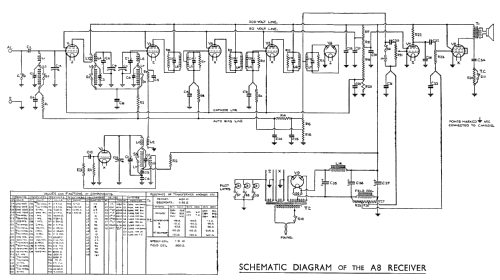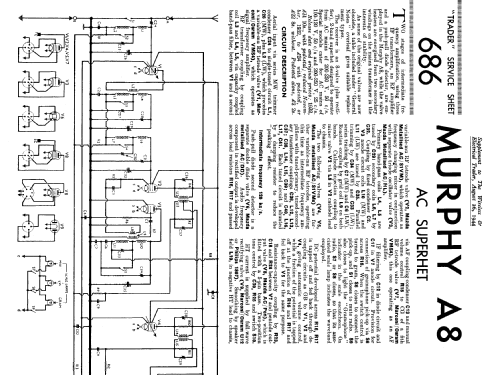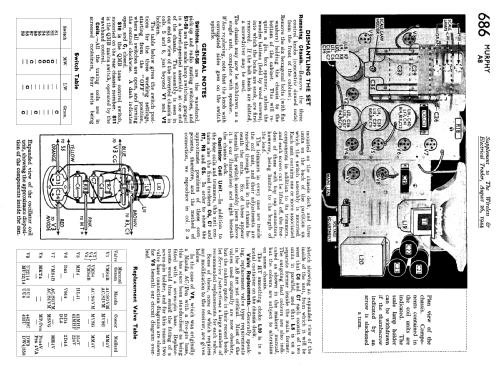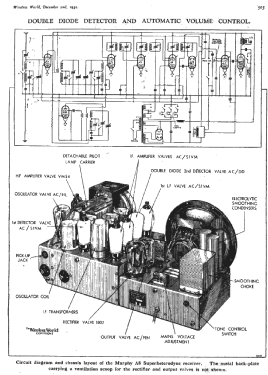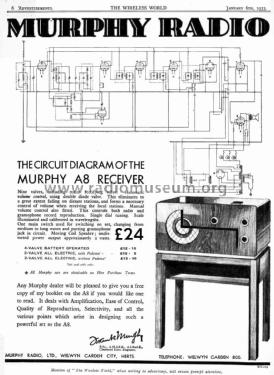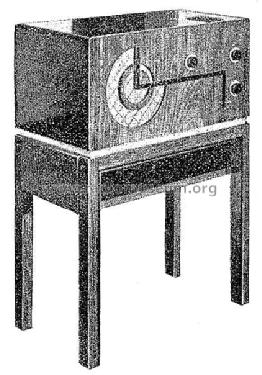- Land
- Grossbritannien (UK)
- Hersteller / Marke
- Murphy Radio Ltd.; Welwyn Garden City
- Jahr
- 1932
- Kategorie
- Rundfunkempfänger (Radio - oder Tuner nach WW2)
- Radiomuseum.org ID
- 77940
Klicken Sie auf den Schaltplanausschnitt, um diesen kostenlos als Dokument anzufordern.
- Anzahl Röhren
- 9
- Hauptprinzip
- Super mit HF-Vorstufe; ZF/IF 120 kHz; 3 NF-Stufe(n)
- Anzahl Kreise
- 8 Kreis(e) AM
- Wellenbereiche
- Langwelle, Mittelwelle (LW+MW).
- Betriebsart / Volt
- Wechselstromspeisung / 200-250 Volt
- Lautsprecher
- Dynamischer LS, mit Erregerspule (elektrodynamisch)
- Material
- Gerät mit Holzgehäuse
- von Radiomuseum.org
- Modell: A8 - Murphy Radio Ltd.; Welwyn
- Form
- Tischgerät-gross, - Querformat (breiter als hoch oder quadratisch).
- Abmessungen (BHT)
- 24 x 12 x 13 inch / 610 x 305 x 330 mm
- Bemerkung
-
FEATURES
General:
Eight-valve plus rectifier, superheterodyne receiver for operation on outside aerial from AC mains.- First Murphy radio with Automatic volume control.
- Moving coil loudspeaker.
- Provision for gramophone pick-up.
- Optional wooden stand, £2/2/- extra.
Circuit:- Signal frequency H.F., bandpass coupled to the first detector (oscillator coupled in cathode lead).
- Two IF stages.
- Double diode second detector with automatic bias control to all preceding stages.
- Screen grid first LF stage, with post detector manual volume control, resistance-capacity coupled to power pentode output valve.
- Full-wave valve rectifier.
Controls:
- Single knob tuning with illuminated and calibrated drum scale.
- Auxiliary manual volume control.
- Wave-range, gramophone, and on-off switch.
- Tone control switch.
Cabinet design:
By R.D. Russell in veneered Walnut. Speaker fabric is silver with blue and black diagonal stripes.
- Originalpreis
- 24.00 £
- Datenherkunft
- Radio! Radio!
- Literaturnachweis
- Wireless World (The), London (WW, 79) (December 2, 1932 Page 502.)
- Autor
- Modellseite von Konrad Birkner † 12.08.2014 angelegt. Siehe bei "Änderungsvorschlag" für weitere Mitarbeit.
- Weitere Modelle
-
Hier finden Sie 367 Modelle, davon 301 mit Bildern und 235 mit Schaltbildern.
Alle gelisteten Radios usw. von Murphy Radio Ltd.; Welwyn Garden City
Forumsbeiträge zum Modell: Murphy Radio Ltd.;: A8
Threads: 1 | Posts: 1
MURPHY A8 SUPERHETERODYNE RECEIVER
A Selective Long-range Set of Advanced Design
This receiver has been designed (quoting the makers' own words) "to obtain, at full room strength, every station on the medium and long wavebands which, at the point of reception, is sufficiently strong, compared with the prevailing noise level, to be of entertainment value."
Some idea of the range may be gathered from the fact that on the first day of test fifteen foreign stations were received at good program strength on medium waves at 10 o'clock in the morning. After dark practically any station in The Wireless World list could be chosen at random and tuned in. The enthusiast would probably succeed in logging seventy or eighty stations during the course of an evening, while those in search of entertainment value would find twenty or thirty programs comparable in strength and quality with their local station.
The selectivity, too, is of a very high order. On a good outdoor aerial, at a distance of only five miles from London Regional, when listening to the Stuttgart (Mühlacker) program at full strength, the only evidence of the existence of the local station was an occasional sideband " splash " during deeply modulated passages. It would be difficult to find a more searching test of selectivity, for the field strength of the unwanted station under these conditions is approximately 100 times that of the wanted station, and the frequency separation is only 11 kc.
Automatic Volume Control.
The only factor which is likely to limit the value of a station from the program point of view is background noise. The set itself, even when giving its maximum amplification, is remarkably quiet having regard to the number of valves employed, while the mains hum is lower than the majority of AC sets so far tested, regardless of type. Heterodyning between stations which are off their proper wavelength is sometimes rather noticeable, but a tone control switch at the back of the set mitigates this trouble at the expense of curtailed high note response.
From the foregoing, it is evident that the Murphy A8 can hold its own, from the point of view of sheer performance, with most receivers in its class. In the smooth and effortless manner in which it achieves this performance, however, it can fairly claim to be unique. The wise adoption of automatic volume control has entirely removed the fierceness which might otherwise be associated with a set providing such high overall amplification. Having adjusted the general level to a volume suited to the room, the tuning scale can be explored without any fear of disruptive noises coming unexpectedly upon a high-powered station. Fading is automatically compensated, and the list of useful stations from the program point of view is thereby considerably extended. Unmodulated carriers which in an ordinary set betray their presence by a faint breathing noise produced the opposite effect in the A8. Between stations, a faint hiss indicates that the set is operating with full amplification on passing through a carrier the background subsides completely and reappears again on the other side. Another interesting effect is to be observed when tuning through longwave stations which appear to occupy an exceptionally wide band with absolutely uniform strength and quality. Some idea of the range of the control may be gained from the fact that the outdoor aerial can be detached, leaving a few feet of the lead in attached to the aerial, without altering the volume in the least. The only change, if the station happens to be a distant one, is a rise in the background noise, but for this one might question the necessity of an. outdoor aerial.
In the space at our disposal, we can draw attention only to a few of the many interesting features of the circuits. Unquestionably, the most intriguing is the employment of a full-wave diode detector, which, in addition to giving freedom from distortion, is also to a large extent responsible for the success of the automatic volume control. The control bias voltages are developed across a potential divider connected between the centre tap of the tuned input circuit and earth. The signal frequency amplifier, the first detector, and the first IF amplifier receives a greater degree of control than the IF stage immediately preceding the detector. The arguments underlying the design of the circuit are very ably presented in a booklet obtainable on application to the makers.
Cabinet Design.
The cabinet follows modern conventions in decoration but is sound in design from the functional point of view. Standing in front of the cabinet, the controls fall naturally to the hands the tuning to the right, and the manual volume control to the left while the calibrated drum dial is viewed downwards through a glass window let into the top of the cabinet. The wave range switch carries contacts controlling pilot lamps which illuminate the appropriate wavelength scale or the panel showing that the set is switched for gramophone reproduction. (A jack is provided at the back of the set for the connection of a pick-up.)
The loudspeaker is on the same level as the controls and is at just the right height for a listener seated in an armchair. It is capable of delivering an ample reserve of power for the average room but showed signs of developing a bass resonance at full power in the particular example tested. At moderate room strength, however, the balance was entirely satisfactory and the general effect well up to the standard demanded in a modern mains receiver.
The feature which leaves the most outstanding impression after more than a week's experience with the set is the flawless functioning of the automatic volume control under the most searching reception conditions. The performance in this respect is really much better than the maker's own figures would lead one to suppose. Add to this the exceptionally high selectivity and range, good quality, and sound engineering construction, and it cannot be denied that the Murphy A8 at its new price is a bargain.
Wireless World December 2, 1932 Page 502
Gary Cowans, 08.Mar.22
